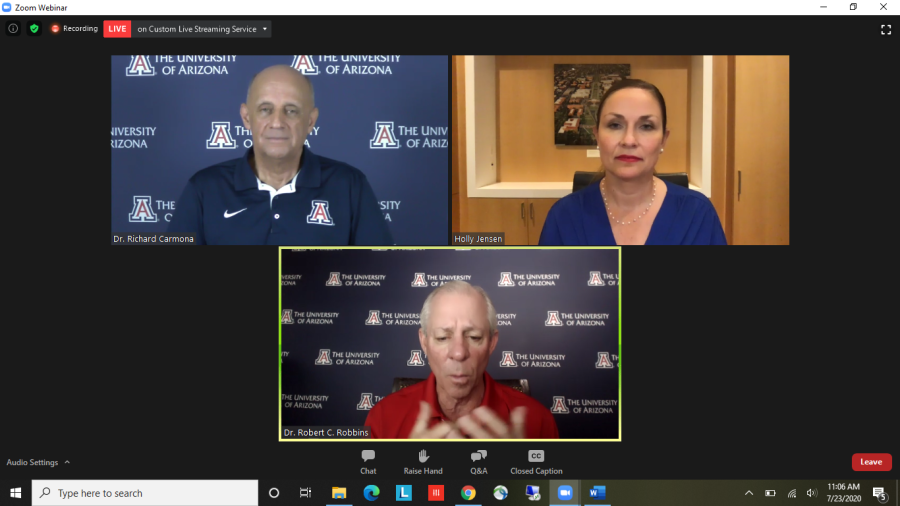University of Arizona President Dr. Robert C. Robbins announced the official return to campus for some in-person sessions and on-campus living at the weekly reentry briefing held virtually on Thursday, July 23 at 10 a.m.
While Robbins has continuously said he intends to open the campus since a late April press conference, he formally declared the return almost exactly one month before the first day of classes, set for Aug. 24, alongside Reentry Task Force Director Dr. Richard Carmona.
“I know many of you are awaiting the answer to the question: ‘Will the University of Arizona be open for in-person classes in the fall of 2020?’ The answer is yes,” Robbins said.
As he detailed in the previous reentry briefing, held Thursday, July 16, Robbins said there will still be the four different class modalities (in-person, flex in-person, live online and iCourse) but roughly 50% of the classes will include some in-person components.
Robbins said he and Carmona have been carefully examining COVID-19 databases including those from Johns Hopkins, the World Health Organization, the Centers for Disease Control and Prevention and The New York Times to aid in their decision.
“As I’ve consistently noted, we’re going to be guided by the science, the data, our ability to provide an environment that offers the simply best in class testing, tracing and treatment methods for students, faculty and staff,” Robbins said. “There are no risk-free options in return to our campus.”
During the briefing, Carmona presented current coronavirus statistics for the U.S., Arizona and Pima and Maricopa counties, along with data from states deemed coronavirus hotspots. He said the number of cases for Arizona has begun to plateau and even decrease.
“If we can get the compliance of students, faculty and staff [to follow] best public health practices, we can continue to drive that curve down and yet have a limited opening of the university,” Carmona said.
In addition to public health data and guidelines, Robbins said he has also taken into account enrollment numbers, which, he said, reflect a desire to come back to the physical university. He said right now, the university estimates about 20,000 people to be back on campus for in-person courses.
“That’s a lot of people, but it’s a lot less than the 60,000 we have during normal times,” Robbins said.
Robbins said the university is looking at the numbers of people who have placed a deposit to live in the dorms and who have signed up for classes. However, he said the university won’t know the exact enrollment numbers for fall until three weeks into the semester itself, as students are able to withdraw and get their tuition back up until that point.
During the briefing, UA Housing & Residential Life sent an email detailing dorm move-in procedures. In previous emails and in the last reentry briefing, it was announced all students will need to get an antigen test on site on their move-in date before moving into a residence hall.
If a student tests negative for COVID-19, they will be allowed to move into their dorm. However, should they test positive, they will need to isolate themselves for a minimum of 10 days before they are allowed to move-in. This isolation may happen in an isolation dorm designated by the university or, if the student chooses, in their own home.
Carmona said the 10-day isolation period was “reasonable” for the majority of COVID-19 patients.
“These are general numbers,” Carmona said. “We know that there are cases where people shed longer than that, but they fall outside the norm.”
The full reentry briefing is available on the UA’s YouTube channel.
Follow Sam Burdette on Twitter









